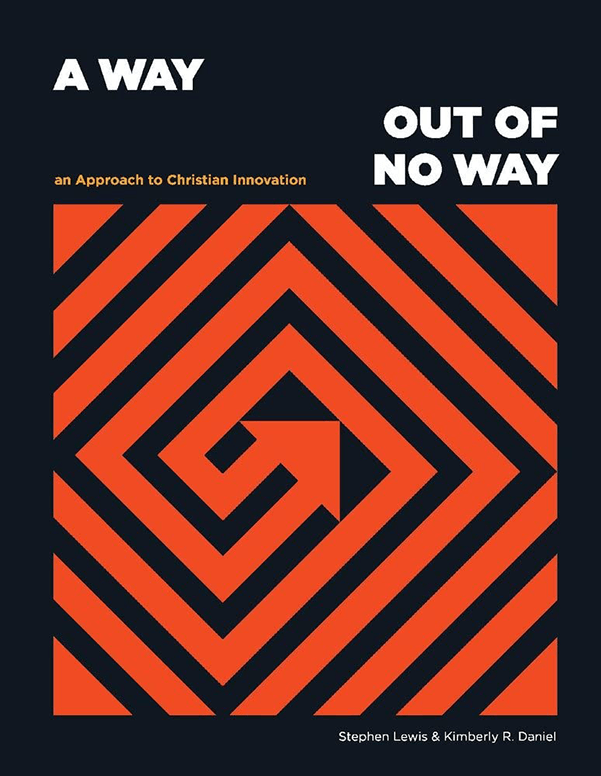October 4, 2022
Kimberly R. Daniel: Christian innovation must change the status quo to help the marginalized

Innovation isn’t Christian if it doesn’t focus on God’s priorities, says the co-author of a book from the Forum for Theological Exploration.
Some modes of innovation focus more on helping existing institutions survive changes in the world rather than changing the world into a more equitable place.
Such innovation, argues Kimberly R. Daniel, isn’t Christian innovation.
“Christian innovation is a type of innovation that advances life,” Daniel says. “It results in healing of the world.”
Daniel and her co-author, Stephen Lewis, have written a resource titled “A Way out of No Way: An Approach to Christian Innovation” with this in mind.
In the book, they offer steps, lessons and examples from the many Christian social entrepreneurs they have met and trained over the past five years to show a mode of Christian innovation that does bring change.

Lewis is the president of the Forum for Theological Exploration, and Daniel is the senior director of communications at FTE and co-founder of an Atlanta-based startup accelerator.
Daniel spoke with Faith & Leadership’s Chris Karnadi about the resource and how readers can use it to identify what next steps might be for their ideas for Christian innovation. The following is an edited transcript.
Faith & Leadership: How did this book come about, and what inspired you to publish it?
Kimberly R. Daniel: Back in 2017, we began to host some small gatherings, which were really sparked by some questions that Stephen and I had. Questions like, “What do Christians from diverse communities think about Christian innovation?” or, “How have they been innovating?” or even, “What innovation have we and our ancestors experienced in our communities before this term was even coined?”
So at FTE, the Forum for Theological Exploration, where both of us are leaders, we hosted these small gatherings of entrepreneurs and asked them those questions — entrepreneurs, pastors, community leaders who were and still are designing and imagining new ways to help their particular communities, versed in their specific contexts.
By launching this five-city listening tour and launching a startup accelerator for early-stage, underrepresented entrepreneurs in 2017, we connected with more than 200 folks — innovators and leaders working at the intersections of faith, church community and business. In this, we learned that not all innovation done by Christians can legitimately claim to be Christian innovation.
Stephen and I both come from the Black community, which has lived on the underside of imperial progress and is well acquainted with frugal innovation, which we commonly call “making a way out of no way” — hence the title of the book.
So from these questions that we had to the small gatherings that we had to the accelerator program and our own lived experiences, we were inspired to write “A Way out of No Way,” because we don’t need any more innovation that gives economic opportunities that benefit just an elite minority.
We want this book to be pretty much a blueprint and a guide to practicing the type of innovation that addresses individual and systemic inequalities that fit the plight of everyday people, not the elite few.
F&L: In your view, what disqualifies something from actually being Christian innovation?
KRD: There are innovative and entrepreneurial endeavors that have nothing to do with the lived experience and the plight of people who are disenfranchised, who are socially vulnerable, who have minimal resources. These types of innovation just didn’t meet what we see as coming from being rooted in Jesus’ teachings and sticking to “the least of these.”
There are a lot of people who are seen as Christian innovators, but a lot of times, they primarily exist to either help their institutions navigate the cultural shifts or to change their institutions to be relevant and responsive to changes in society. So in these cases, innovation is a practice for Christians for the primary benefit of the institutions, their traditions and their programing.
While there is definitely importance in this type of innovation, given all the challenges that people and religious institutions have faced, especially over the past several years, this is insufficient to be understood as Christian innovation.
I think it’s a misconception that if Christian leaders effectively navigate their institutions through these difficult challenges and keep their institutions and people intact or they successfully transfer the institutions, that they’re deemed innovative. Yes, they may be deemed innovative, but when we’re talking about Christian innovation in particular, in our book we advocate for what’s rooted in Jesus’ teachings about God’s preferential starting place — to benefit the disenfranchised, socially vulnerable, underresourced and undervalued.
F&L: What are some models you’ve found that are truly Christian innovation?
KRD: If we’re talking about people who are doing innovation rooted in addressing these particular communities, that might be someone like Kit Evans-Ford, who went through the accelerator program in 2017 that Stephen and I co-founded.
She developed and launched and has a thriving business that she calls her ministry that is rooted in addressing women who are survivors of domestic violence and abuse. Her business ties into her own story and into her ancestors’ stories and is helping create a healing community for these women who have often been overlooked and who have just been trying to survive.
She is giving them a place and a space to thrive, giving them an opportunity to create some economic value by employing these women, giving them free services to help them heal as they move through their journeys. So whether that’s spiritual reflection or therapy or a chiropractor or coming together and having some studies with one another, she is providing this community center, and she’s providing a place to employ these women.
That’s one example. There are six steps in the book about how to do Christian innovation, and she’s tied to the last step, which we name “Do it,” when you’re actually implementing your solution. That’s the very last step. She has gone through all the steps, and she is doing the work for the benefit of a particular community.

Or another example might be LivFul, which was co-founded by Hogan Bassey, who is a Nigerian-born man who was experimenting with a solution to a problem that his particular community faced, which was malaria.
He had been infected with malaria four or more times by the time he was 10 years old, and so he started testing out an insect repellent that soon became the seed for LivFul, which initially offered this award-winning insect repellent to heal his community and also provide them with an opportunity to have access to it, because repellents were [not readily accessible] to them at the time.
He provided easy access to this insect repellent so that he could save lives and hopefully help people flourish. LivFul offers a lot more now, but that’s just a little highlight.
F&L: What do you hope readers would learn from the book?
KRD: We hope that through this book people are able to have concrete steps they can take and practices they can engage in to help them identify their next most faithful step in exploring innovation.
We want them to understand what Christian innovation truly is, and what we are advocating for, which again, like I’ve already said, is rooted in Jesus’ teachings, addressing those who are disenfranchised, undervalued, vulnerable in our families, in our communities and in our society.
That is very important, and we hope that the book serves as a blueprint for innovators, for people who may be innovators, people who are leaders, educators, and for communities, to create a more just world by developing solutions to stubborn social problems.
This book is really for people who are innovators — innovators who are within the church context or other forms of faith communities, people who are drawn toward social entrepreneurship and driven by their faith to make a positive impact on communities.
This book is for educators who are teaching the innovators who will come into our communities. This book is for communities in and of itself. We want people to be clear about the ways that they can faithfully do innovation that meets the needs and provides healing and opportunities for flourishing and empowers everyday people.
F&L: How should a reader use the six steps that you outline in the book to identify Christian innovation?
KRD: In every chapter, it begins with an overview of that particular step. I think someone who is already working on some type of innovative ministry or has an entrepreneurial venture that they’re trying to develop would get clear about whether that’s the step they’re at and the one they should focus on.
I think what is a benefit to this particular book is that in each step, you can go to the end with these interactive exercises that will give you some concrete and tangible practices and questions that you can consider that will help you refine what it is that you’re doing to make sure that you’re actually meeting the needs of people within your community. I would say to start there.
But in looking at the steps just broadly, it’s pretty clear that when you “Get curious,” you’re really starting with a question. You’re wondering why things are the way they are in order to develop a solution, whether it’s a ministry or a business venture. You’re getting curious about the problem, the need, the desire that you see within a particular community.
Then you’re moving from that and you “Make meaning” of what is coming up — what came up in your curiosity and what that might mean for these insights. Then you need to “Be open” to what emerges from God, what emerges from your community in order to further build out your ministry.
Then you just need to try it, experiment with it, develop something. Even if it’s not perfect, “Try this” to see if it even works, and then show that you can “Prove it” works, from hearing from the community. Ask and see if it’s actually making an impact in the way that you hope it does.
Once you prove it, just “Do it.” Looking at the highlights of each step, I think, will give people a sense of where they might need to focus, and then leveraging the interactive exercises that we have at the very end following Stephen’s theological reflections can be very helpful.


Share